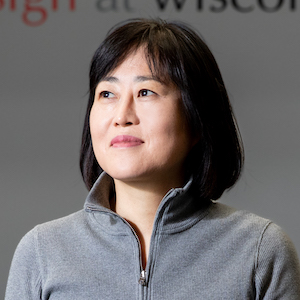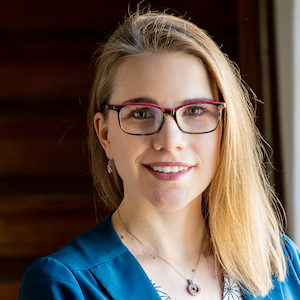When you think of research, you might envision study teams designing experiments or conducting surveys.
While research across the School of Education’s departments of Art, Dance, and Theatre and Drama might sometimes look different, faculty in these areas are engaged in projects that are examining social issues, deepening understanding of history, and advancing their artistic fields.
Read on to learn about some of this groundbreaking research.
Spotlighting ‘social homelessness’
Yeohyun Ahn’s project, “Social Homelessness on U.S. Campuses,” brings together multidisciplinary art and design research to explore isolation among Asian female faculty members in higher education.

Ahn is an assistant professor in the Art Department. Originally from South Korea, Ahn came to the U.S. for graduate school, then worked at the School of the Art Institute of Chicago before accepting a faculty position at Valparaiso University in Indiana.
At Valparaiso, a predominantly white institution, Ahn experienced greater isolation than she had previously. “It was only an hour from Chicago,” she says, “but I became very aware that I was treated differently.”
This sense of isolation led to Ahn co-founding a group, Asian Female Scholars, with Mary Szto, a former law professor at Valparaiso who currently is at Syracuse University. The group hosted gatherings to provide Asian female faculty members in northwest Indiana with support and comradery.
It was through a book, “Here I Am: Faith Stories of Korean American Clergywomen,” by Grace Ji-Sun Kim, that Ahn was first introduced to the concept of “social homelessness,” or isolation due to a lack of community to associate with or rely on. Ahn was inspired to use interactive art technologies to illuminate social homelessness among Asian female faculty members in the U.S.
Ahn explains that many Asian female faculty find themselves doubly marginalized. While feeling isolated or invisible on campus, those from traditionally patriarchal Asian cultures may also find they lack support as professional women within their communities.
The current iteration of Ahn’s project, “Being Ignored 2.0,” focuses on communicating isolation through photographs people take of themselves, or “selfies,” that are altered using a custom app Ahn created.
The app applies light and a computer algorithm to create a sense of being “erased.”
“The selfie is a form of art,” Ahn said during a presentation at UW–Madison’s Diversity Forum. “They are not always as spontaneous as they seem, and they can be a visual communication tool used purposefully to express feelings.”
Learn more: socialhomelessness.com
Dancing the Greek crisis
When you ask people what they know about Greece, they tend to talk about “mythology or democracy or the ancient Greek ideals,” says Natalie Zervou, an assistant professor in the Dance Department.

Those ideals have long been central to Greek identity, and dance performances within the country have historically focused on presenting narratives that celebrate them. That is, until the financial crisis in Greece that began in 2009 upended life, and disrupted traditional funding for the arts.
Zervou argues that dance played a pivotal role in reconsidering the Greek identity during the financial crisis.
Before the crisis, the arts in Greece were largely funded through government subsidies, which artists and companies would apply for every year. In 2011 — two years after the crisis began — that funding stopped, and artists had to adapt.
“There were more site-specific performances, and people were reclaiming old theaters or abandoned buildings and performing art there,” Zervou says. “A lot more collectives formed, and initiatives, such as ‘pay what you can.’ ”
In addition, the narratives presented on stage began to shift.
“There was a lot more freedom, because artists didn’t have to satisfy any government appointed committee. So they started being much more critical about who we are,” Zervou explains.
Artists began tackling aspects of Greek history — such as political instability after World War II — that challenged glorified ideals of the past, and taking on present-day issues, such as the refugee crisis and racism, that coexisted with the financial crisis.
A native of Greece, Zervou conducted her research through ethnography: She went to rehearsals, spoke with artists and scholars, and attended performances. She is documenting her research in a book to illuminate the human experience of living through crisis.
“I think that a lot of times when crises are studied, it’s really focused on statistics and not people’s lived experience and bodies moving in space carrying those experiences,” she says. “And I think that’s what a dance studies approach can add.”
Finding connection in virtual performance
When the COVID-19 pandemic shuttered theaters, many theater artists turned to the digital realm to keep their art alive.

But according to Megan Reilly, an assistant professor in the Department of Theatre and Drama, it proved difficult for artists to forge a real connection with their audience through a computer screen.
“What I wanted to do was to solve that problem of the actor-audience connection in this virtual space,” she says.
Reilly has long studied immersive theater, where the audience is immersed within — and may engage directly with — the performance. She wondered if she could recreate a previously performed immersive work in virtual reality.
To study this, she turned to an immersive performance by British performance artist Adrian Howells, presented in Glasgow, Scotland, in 2009.
Howells, who died in 2014, was known for creating intimate, one- on-one performance experiences.
For his work that Reilly intends to recreate, “The Garden of Adrian,” Howells took individual audience members on a journey, including stations focused around sensations such as touch, taste, and smell. Following the journey, audience-participants had the opportunity to reflect on the experience.
Reilly is working with UW–Madison student Arthur Sommer and with experimental theater artists from Austin, Texas, to build a virtual environment for “The Garden of Adrian.”
“We’re going to treat it as an experiment, not a public performance,” she says, “and invite people to come in and experience (the performance) and document how they feel.”
“If I can replicate the feelings and emotions and connections (of the performance) in virtual reality, without having the physical presence of an actor, or the actual ability to taste strawberries … maybe we can workshop this to get to the emotional essence.”
Her goal is to improve virtu- al theater experiences, as they become more widespread and sometimes necessary — as during the COVID-19 pandemic shutdown.
“I think that we’re going to discover some ways that actors and creators can work in this space that will actually improve how we connect to audiences in virtual theater,” Reilly says.